The Different Kinds of Exoplanets You Meet in the Milky Way
At a glance:
- Exoplanets are planets that orbit other stars. Some look like planets in our own solar system, while others are dramatically different.
- Exoplanets seem to follow the same general rules as the planets in our solar system: Small planets are rocky, big planets are gassy, and the ones in between may be watery.
- There are other rocky worlds orbiting stars at the right distance to allow liquid water to exist. We don’t know yet if any other world supports life.
There are more than 4,000 known exoplanets, bewildering in their
variety. Some are familiar to us, worlds analogous to Venus or Neptune.
Others are like nothing in our own solar system, so we describe them as hot Jupiters, carbon planets, and super-Earths. Their names are an
alphabet soup, derived from star catalogs, telescopic sky surveys, and space telescopes: CoRoT-7b, Kepler-10c, and TRAPPIST-1a. What are these worlds that orbit other stars?
Fifteen types of exoplanets are currently listed in the Unified Astronomy Thesaurus, and a few more names pop up in the literature. These types aren’t distinct; exoplanets can be described in more than one of these different ways. Five of the exoplanet types refer only to size (mass and diameter). In order, from smallest to biggest, they are rocky planets; super-Earths; mini-Neptunes; ice giants; and gas giants. Planets in the super-Earth and mini-Neptune size range may be ocean planets, having liquid-water oceans hundreds of kilometers deep. Some rocky planets in especially carbon-rich systems may be ultra-dry carbon planets, having rocks formed of compounds of silicon and carbon, different from our solar system’s silicon-and-oxygen rocks.
There are several exoplanet types that depend both on a planet’s size and its location within a stellar system. Hot Jupiters and hot Neptunes are big, gassy planets in tight, fast orbits around their stars. Traveling so close, they’d be tidally locked, with a hot hemisphere permanently facing the star and a cold hemisphere permanently facing out. (Objects close to large gravity sources get stretched a little bit, which slows their spin rate to match their orbital period. This is why we always see the same side of the Moon from Earth.)
There are cold Jupiters and cold Neptunes as well, orbiting farther out, just like the planets they’re named after. Lava planets are superdense larger-than-Earth worlds in close, hot orbits; they don’t seem to occur farther out. Some of them, known as Chthonian planets, are likely the remnant cores of evaporated hot Jupiters. (The name, pronounced “THO-nee-an,” refers to the underworld.) Habitable planets are Earth-sized ones that orbit at a distance from their star where liquid water could be stable, meaning they could be habitable to life as we know it, under the right circumstances. Every star has a habitable zone, a range of distances in which surface liquid water could be stable. If stars are small and dim, habitable planets can have close orbits and be tidally locked.
Finally, any size of planet can be found in a few especially strange locations. There could be Trojan planets, smaller co-orbital companions to larger planets, though none have been certainly identified yet. (Our solar system has Trojan asteroids co-orbiting with many of the planets, but they are all far too small to be planets.) Pulsars—ultradense, rapidly spinning neutron stars with unimaginably intense magnetic fields—are such weird stellar objects that pulsar planets get their own moniker, too. And finally there are free-floating planets, also known as rogue planets, which have been ripped free from their stars through an unlucky gravitational encounter with a more massive object and journey alone through the galaxy. They are hard to find and we’ve found only one so far, but there are probably lots of them out there.
Now that you’re acquainted with the different types of exoplanets, let’s look at some of the better-known examples and see what kinds they are.
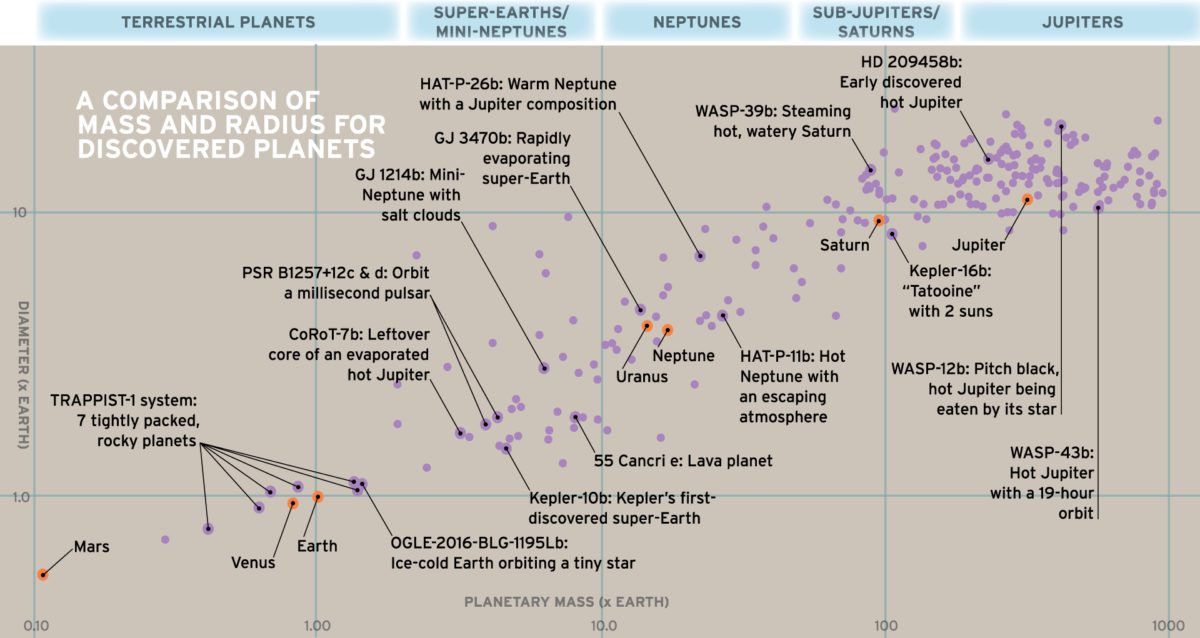
Rocky planets
TRAPPIST-1: The one with lots of Earths
TRAPPIST-1 is only 40 light-years away, and contains at least 7 worlds, of which 5 (lettered b, c, e, f, and g, in ascending distance from their host star) are Earth-sized or bigger; the others are less massive than Earth but more massive than Mars (Mars is just 10 percent as massive as Earth). The Transiting Planets and Planetesimals Small Telescope (TRAPPIST) in Chile discovered the first 3 of these by transit photometry in 2016. Later, astronomers used both NASA’s Spitzer Space Telescope and ground-based telescopes to monitor the star for transits and conclude that TRAPPIST-1 has at least 7 planets whose orbits are aligned with the spin of their star. The discoverers think that the planets originated farther from the star and migrated inward. A more distant origin means they could be water-rich, because worlds that form far from stars end up icier. TRAPPIST-1 is an ultra-cool dwarf star, and planets e, f, and g are at the right distance to place them in the habitable zone. Also, you can make music with TRAPPIST-1’s planets.
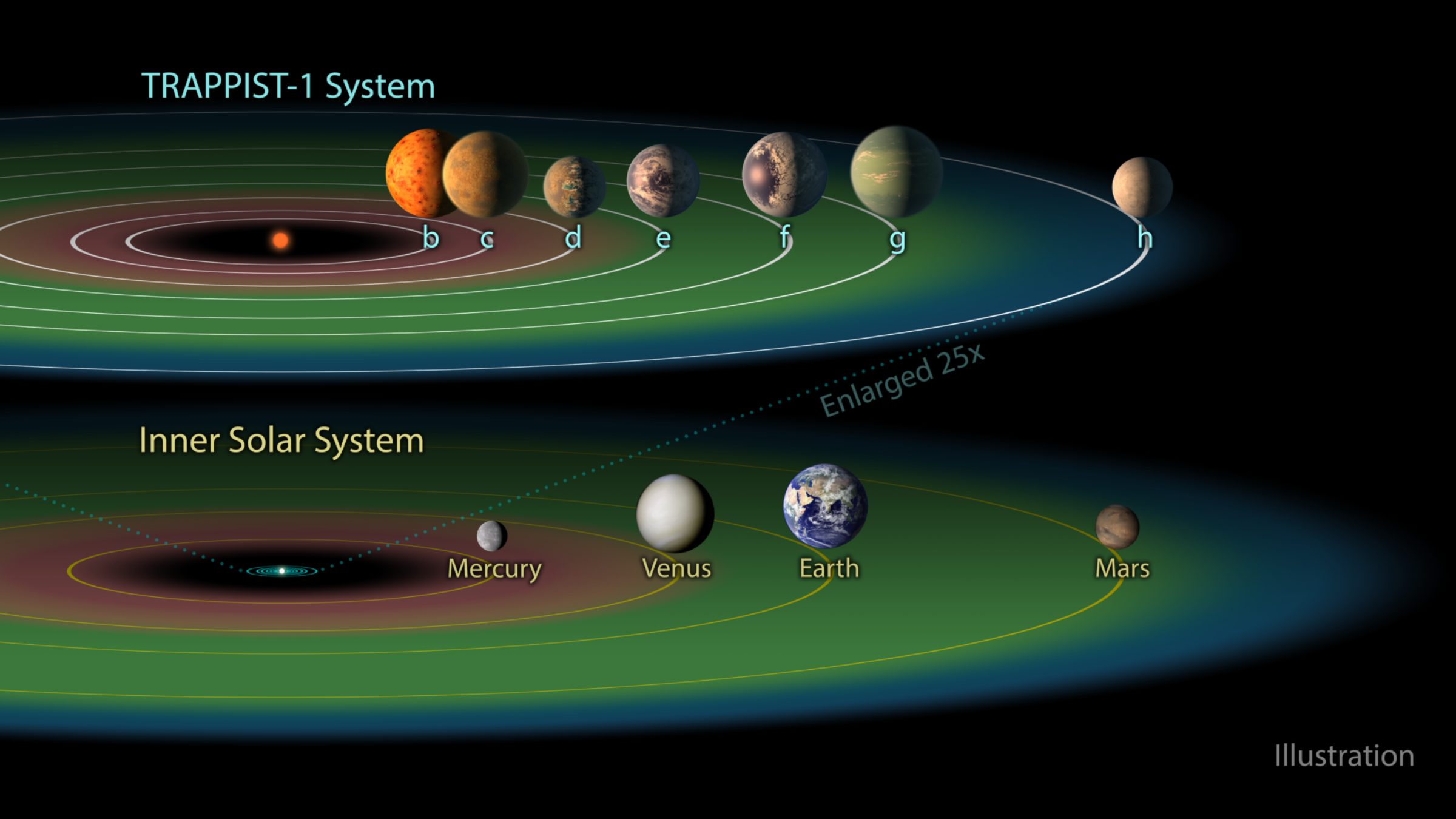
OGLE-2016-BLG-1195 Lb: The one that’s like Earth in a freezer
Some 12,800 light-years away, an Earth-sized world orbits in an Earth-distance orbit around a very tiny star. Because the star is so small and cold, the planet is probably super-cold and lacks an atmosphere. Like Triton or Pluto, materials that would be gases if they were warmer (like methane and carbon dioxide) are probably frozen to the surface. OGLE-2016-BLG-1195Lb was discovered by the microlensing technique using Spitzer and the Korea Microlensing Telescope Network.
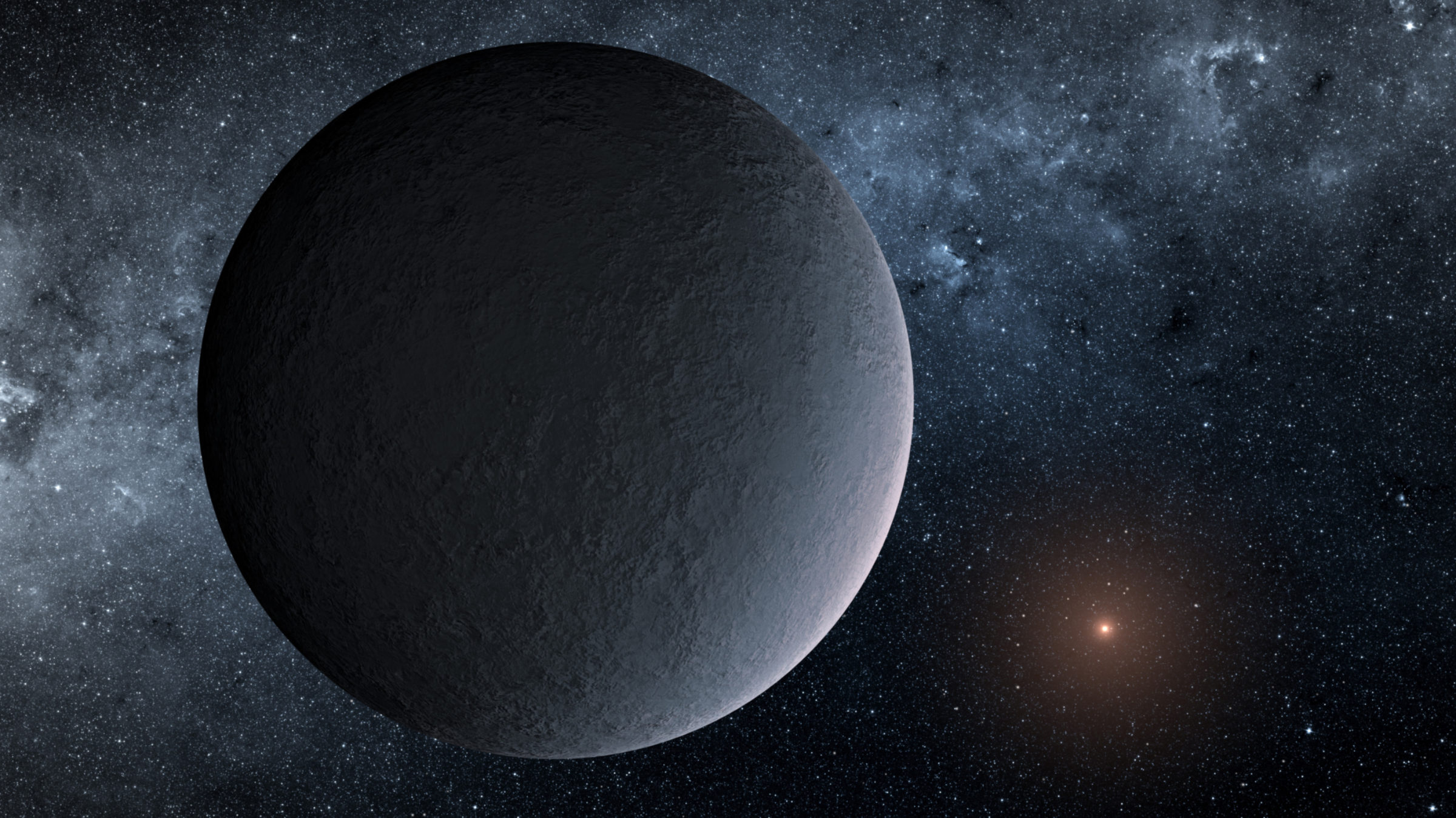
PSR B1257 + 12 system: The ones that orbit a pulsar
“The exoplanets PSR B1257+12 b, c and d were among the first discovered, and also happen to be three of the weirdest,” NASA says. Planets c and d were discovered in 1992 using the Arecibo radio telescope, orbiting a millisecond pulsar that was discovered in 1991 and is located about 1,000 light years from Earth. Arecibo detected tiny variations in the timing of the arrival of the pulsar’s radio pulses that betrayed the presence of planets. In 1994 a third, inner planet was found that is smaller than Mercury. The planets could not possibly have survived the supernova that created the pulsar, so they must have condensed around the star from a disk of material left behind by the explosion. What the surface of rocky worlds orbiting the remains of a star blasting out intense electromagnetic radiation look like is anybody’s guess, but the magnetic fields very likely create auroras on the planets.
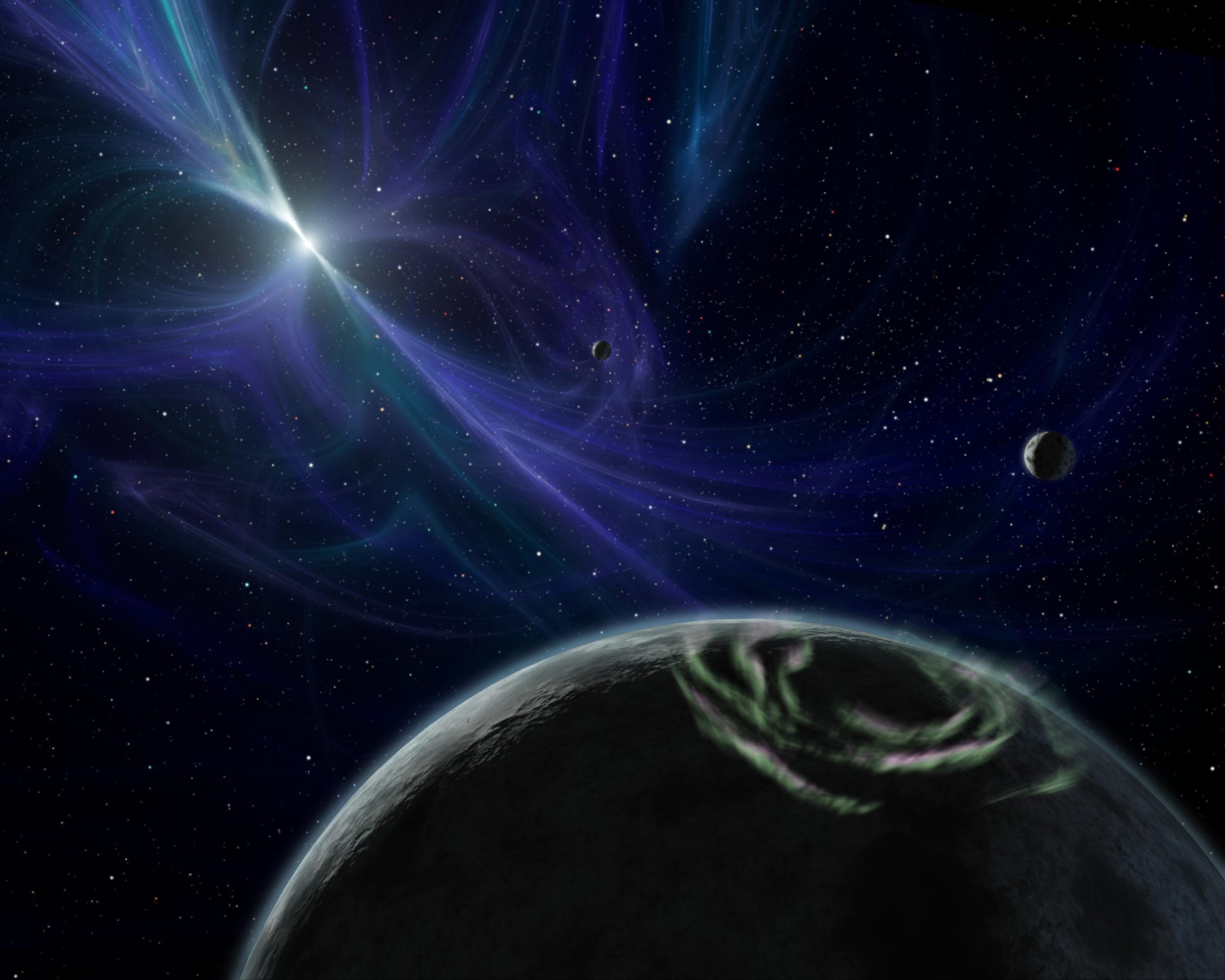
Lava Planets (Also Known As Hot Super-Earths or Super-Ios or Sometimes Chthonian Planets)
Kepler-10b: the one that’s like Earth if you ignore the fact that its rocks are melted
Kepler-10b was the first rocky planet that NASA’s Kepler Space Telescope found, using transit photometry, and it orbits a Sun-like star, albeit one much older than the Sun. However, Kepler-10b is much larger than Earth, with a diameter 1.4 times bigger and a mass 3.5 times bigger, and it orbits its star incredibly closely, taking only 20 hours to circle it at an altitude only about 1.5 times the diameter of the star itself. It must be tidally locked, so must be molten on its dayside, but its surface would be solid on its cold nightside.
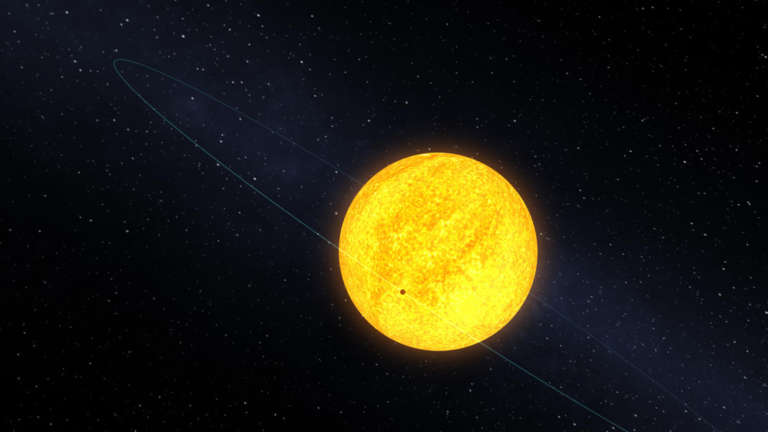
CoRoT-7b: The Cthonian planet that’s probably an evaporated Jupiter
CoRoT-7b was the first-discovered rocky planet, found by the French satellite CoRoT (Convection, Rotation and Planetary Transits) in 2009, using transit photometry. It is much like Kepler-10b: 1.6 times bigger than Earth, with 5 times the mass, in a tiny 20.4-hour orbit that has likely left it tidally locked, with a global molten lava ocean surface. Scientists have speculated that it’s the leftover core of a gas giant, and that it might be more accurate to call CoRoT 7b and Kepler-10b a type of “super-Io” than “super-Earth.”
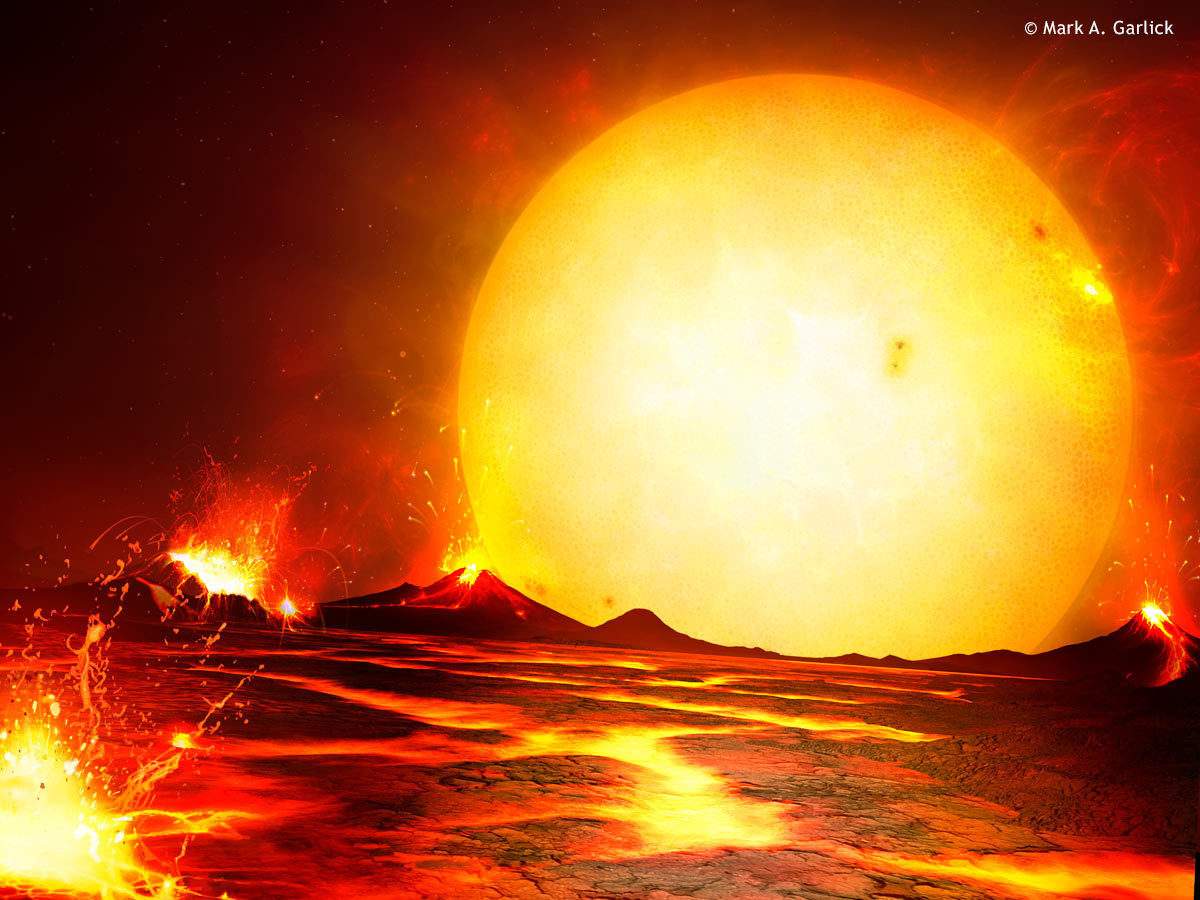
55 Cancri e: The Chthonian planet with sparkle skies
55 Cancri e is larger than CoRoT-7b or Kepler-10b but otherwise similar: a rocky planet orbiting intensely close to its star, molten-surfaced and tidally locked. Another difference is that we’ve actually measured the temperatures on the dayside and nightside of 55 Cancri e: 2,700 kelvins on the dayside and “only” 1,400 Kelvins on the nightside. (The nightside temperature is right around the melting temperature of planet-forming rocks; it’s easy to imagine that side of the planet having a barely-solid surface that's continuously sinking in patches back into the molten lava below.) 55 Cancri e probably has an atmosphere of carbon dioxide and evaporated rock, which might condense into mineral clouds in the atmosphere on the nightside. In other words, it rains sand. (The same might also be true for CoRoT-7b and Kepler-10b.)
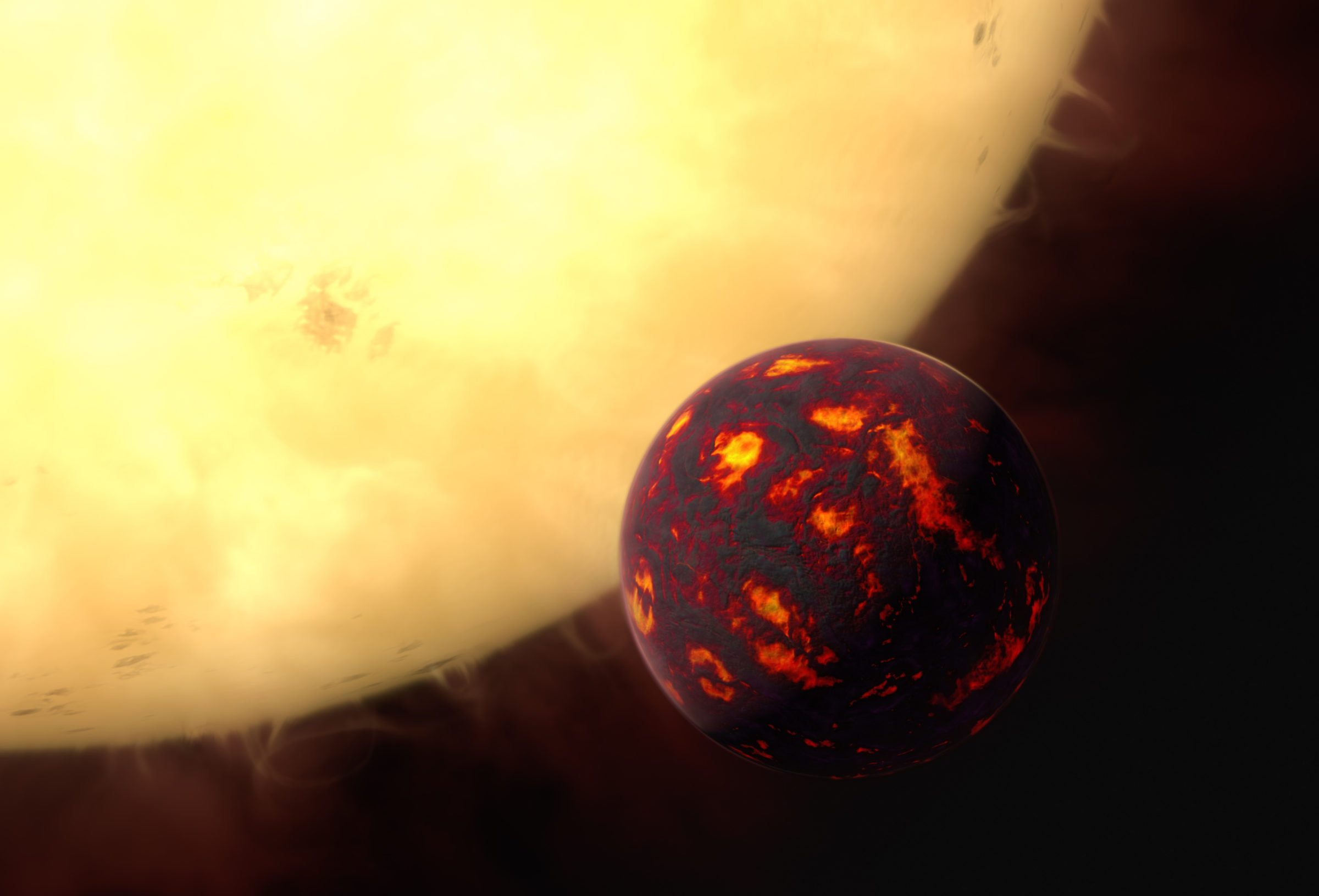
Mini-Neptunes or Super-Earths (Which Might Be Ocean Planets but It’s Hard to Tell Because They Have Clouds)
GJ 1214b: Mini-Neptune with salt clouds
GJ 1214b is another early discovery, found by the ground-based MEarth project in 2009. It orbits a red dwarf star every 1.58 days at a distance of only 2 million kilometers, making it another hot world, but not as bad as the lava planets, at only 230 degrees Celsius. It is 2.6 times the diameter of Earth but only a third as dense, which means it is not mostly rock like Earth but must have a significant amount of water and/or hydrogen and helium. This means it could have a liquid-water ocean hundreds or thousands of kilometers deep hiding under its atmosphere. Scientists have tried to find out what the atmosphere of GJ 1214b is made of, but seem to have been stymied by the presence of high clouds, which block our view of what’s below.
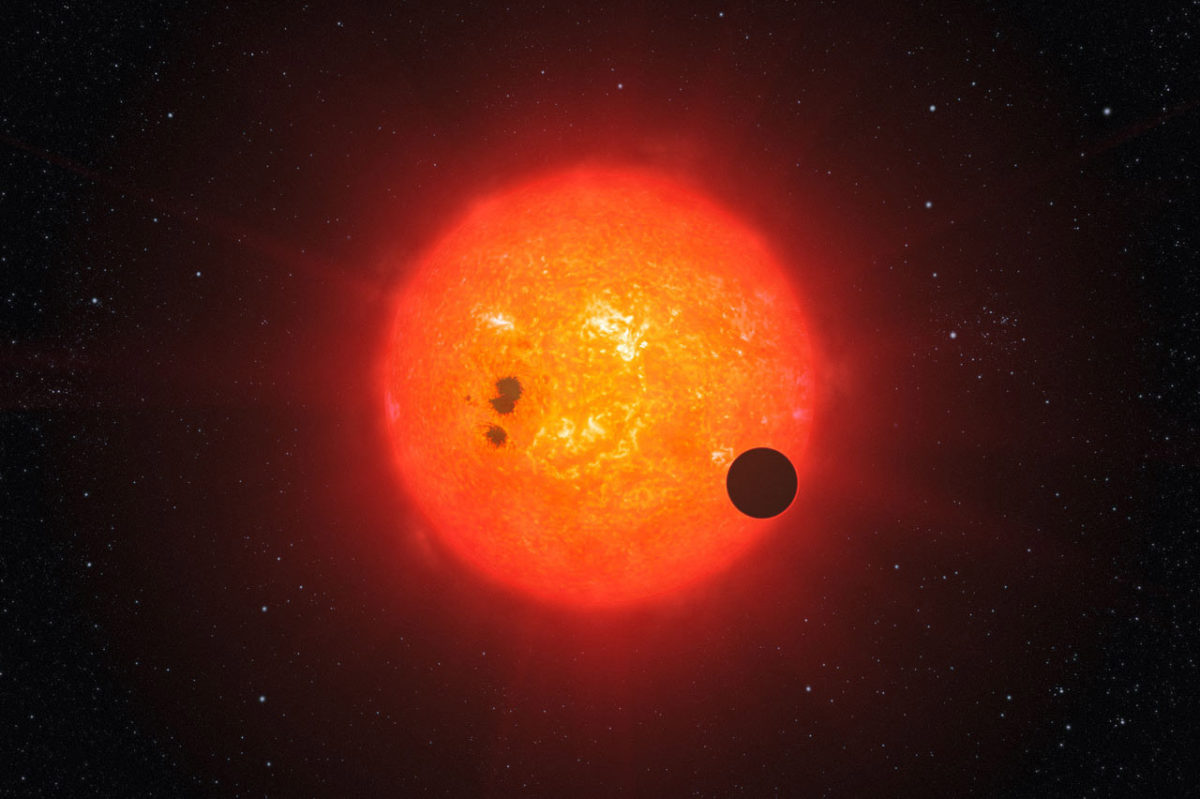
Wolf 1061c: the one that’s really close by and might be habitable
Wolf 1061 is a red dwarf about a third the mass of our Sun and only 13.8 light years away. It is orbited by at least 3 planets, the innermost of which (Wolf 1061b) is rocky; the other two are super-Earths or mini-Neptunes. Wolf 1061c, with a mass of 3.4 times Earth’s, orbits in the star’s habitable zone, close to its inner edge, while the outer, larger Wolf 1061d (about 8 times Earth mass, or half the mass of Neptune) travels just beyond the outer edge. Wolf 1061c is probably tidally locked, and although it’s in the habitable zone, what any habitable environments on it would look like is not very clear. We don’t know whether the high-pressure, high-temperature oceans on super-Earth ocean worlds would be conducive to biological chemistry.
Kepler-22b: Another super-Earth in the habitable zone of a Sun-like star
When it was discovered in 2011, Kepler-22b was the closest thing to another Earth then known: a smallish planet in the habitable zone of a Sun-like star, orbiting far enough away not to be tidally locked, in a 290-day orbit. However, it’s not small enough to be another Earth. At 2.4 times Earth’s diameter, it is a super-Earth or sub-Neptune, probably an ocean world.
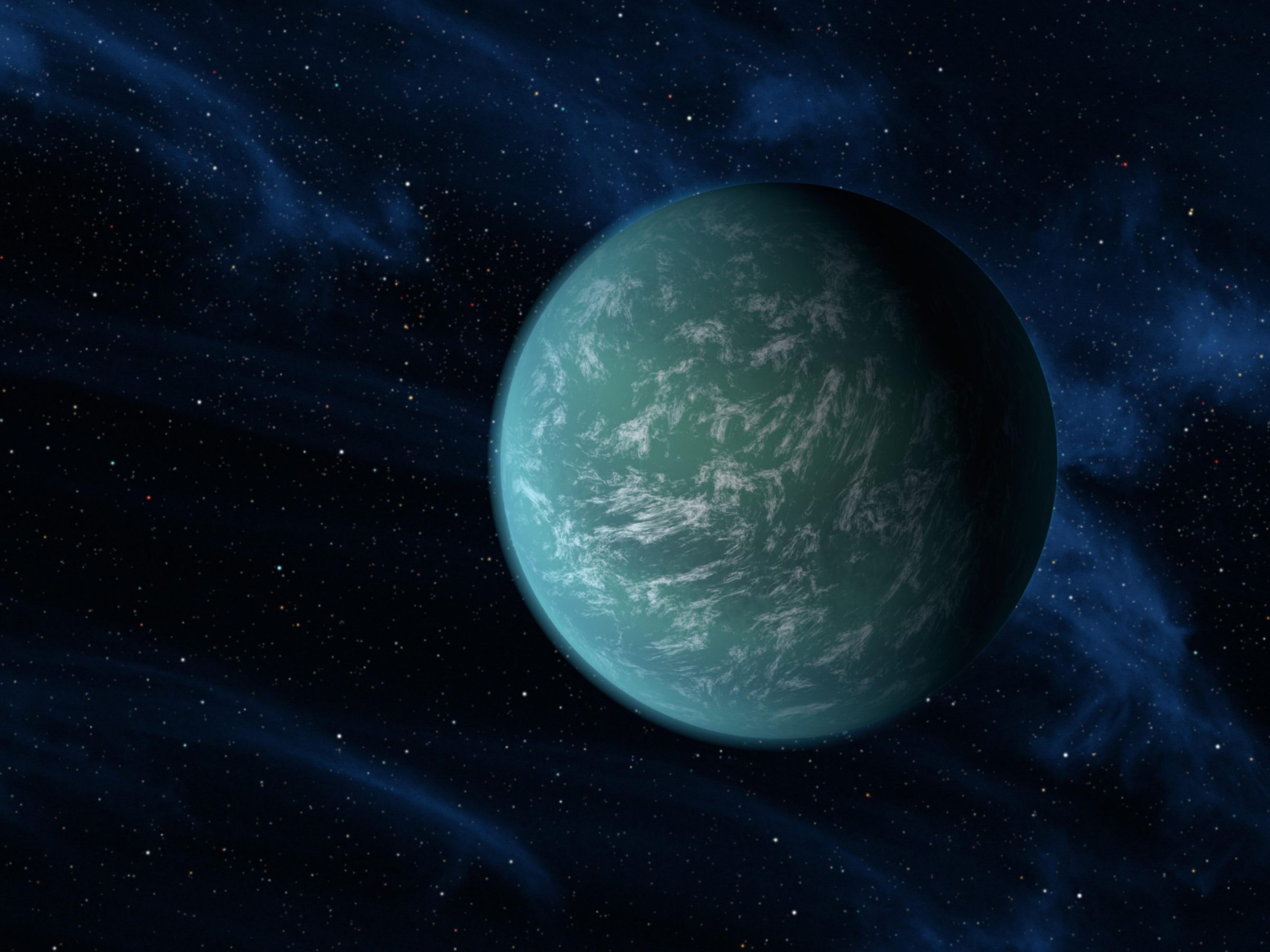
Cold Jupiters and Neptunes
Kepler-16b: The one with two suns, so people call it “Tatooine” even though it’s Saturn-sized
Kepler-16b orbits a pair of stars that are smaller than the Sun, the first such circumbinary planet discovered. The two stars orbit each other with a period of 41 days, while the planet circles the both of them in a wider orbit taking 229 days. The planet is slightly smaller than Saturn and orbits within the system’s habitable zone. It would not have any solid surface, but any moons could. Like Saturn, it’s probably made mostly of metallic hydrogen.
Hot Jupiters/Hot Neptunes
Kepler 11: The one with lots of power in an itty bitty living space
The Kepler-11 system includes at least 6 planets within an orbital range that, if placed in our solar system, would barely extend beyond that of Mercury. Planets b through g have masses of 1.9, 2.9, 7.3, 8.0, 2.0, and something under 10 times that of Earth. Planet Kepler-11e is a hot Neptune, having slightly less than half the mass of Neptune but nearly the same diameter, a sign that its outer layers have puffed up due to proximity to the host star. Planet Kepler-11c is a very puffy sub-Neptune. Like Neptune, the hydrogen in its interior is likely in the form of superionic water.
GJ 3470b: The one that’s blue as Neptune but evaporating
With a mass more than 12 times that of Earth, GJ 3470b is firmly in the Neptune category but circles its star every 3.3 days. It was discovered by the radial velocity method and later observed transiting its host star. Followup observations with ground-based telescopes yielded the discovery of Rayleigh scattering in its atmosphere—in other words, its sky is blue. Hubble observations showed that GJ 3470b is rapidly losing its atmosphere, perhaps in the middle of evolving from an inflated hot Jupiter into a Chthonian, lava-covered, gas-poor world.
51 Pegasi b: The one orbiting a Sun-like star
The first planet to be discovered (in 1995) orbiting a Sun-like star, 51 Pegasi b is nothing like Earth. Its orbit takes only 4 days to complete, and the planet has a mass half that of Jupiter. We know its mass, but not its diameter, because it was discovered with the radial velocity method; however, a planet with so much mass must be a gas giant. 50 Pegasi b is the prototypical hot Jupiter.
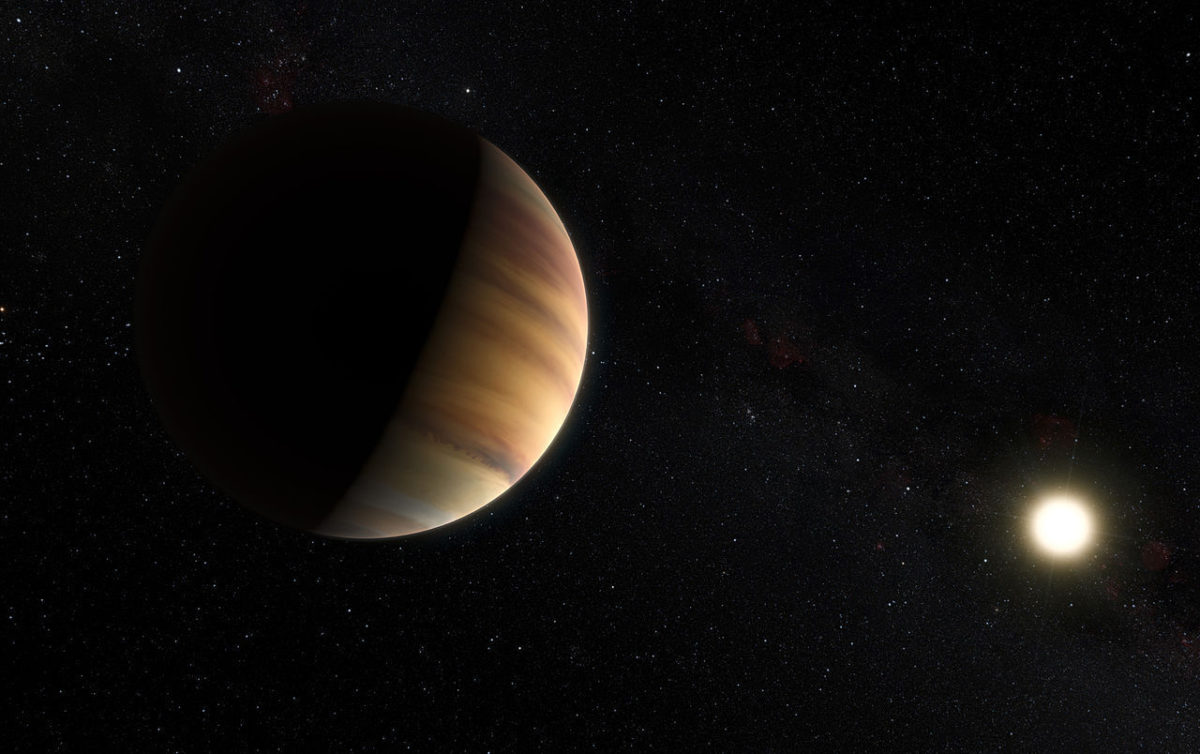
HD 189733b: The one where it rains glass sideways
One of the hottest of hot Jupiters, HD 189733b was discovered in 2005 by astronomers at the Haute-Provence Observatory in France. It is slightly larger in both mass and diameter than Jupiter, and orbits its star every 2.2 days at only 3 percent of Earth’s distance to the Sun. Followup observations with Spitzer showed strong temperature differences between the day and night sides, which should be common among hot Jupiters, since they orbit close enough to their host stars to be tidally locked. The temperature difference, combined with the gaseous composition of hot Jupiters, would naturally produce fierce winds blowing from dayside to nightside. Further observations with the Hubble Space Telescope’s imaging spectrograph revealed HD 189733b’s color to be a deep, dark blue, much bluer than Uranus or Neptune. The observation was later confirmed with SOFIA. The color probably arises from silicate particles—that is to say, droplets of glass—in the atmosphere.
KELT-11b: The one that’s as puffy as Styrofoam
KELT-11b is really feeling the heat. It’s in a 4.5-day orbit around a large, subgiant star. It’s less massive than Saturn, but has a bigger diameter than Jupiter, giving it an overall density less than one tenth that of water. Given its mass, that likely means it has a hugely inflated atmosphere, excited to dizzying heights by the heat of the nearby star, enveloping a much denser interior. The star is at a critical phase in its evolution, having exhausted the hydrogen in its core, and likely only tens of millions of years away from bloating into a giant that will engulf poor KELT-11b.
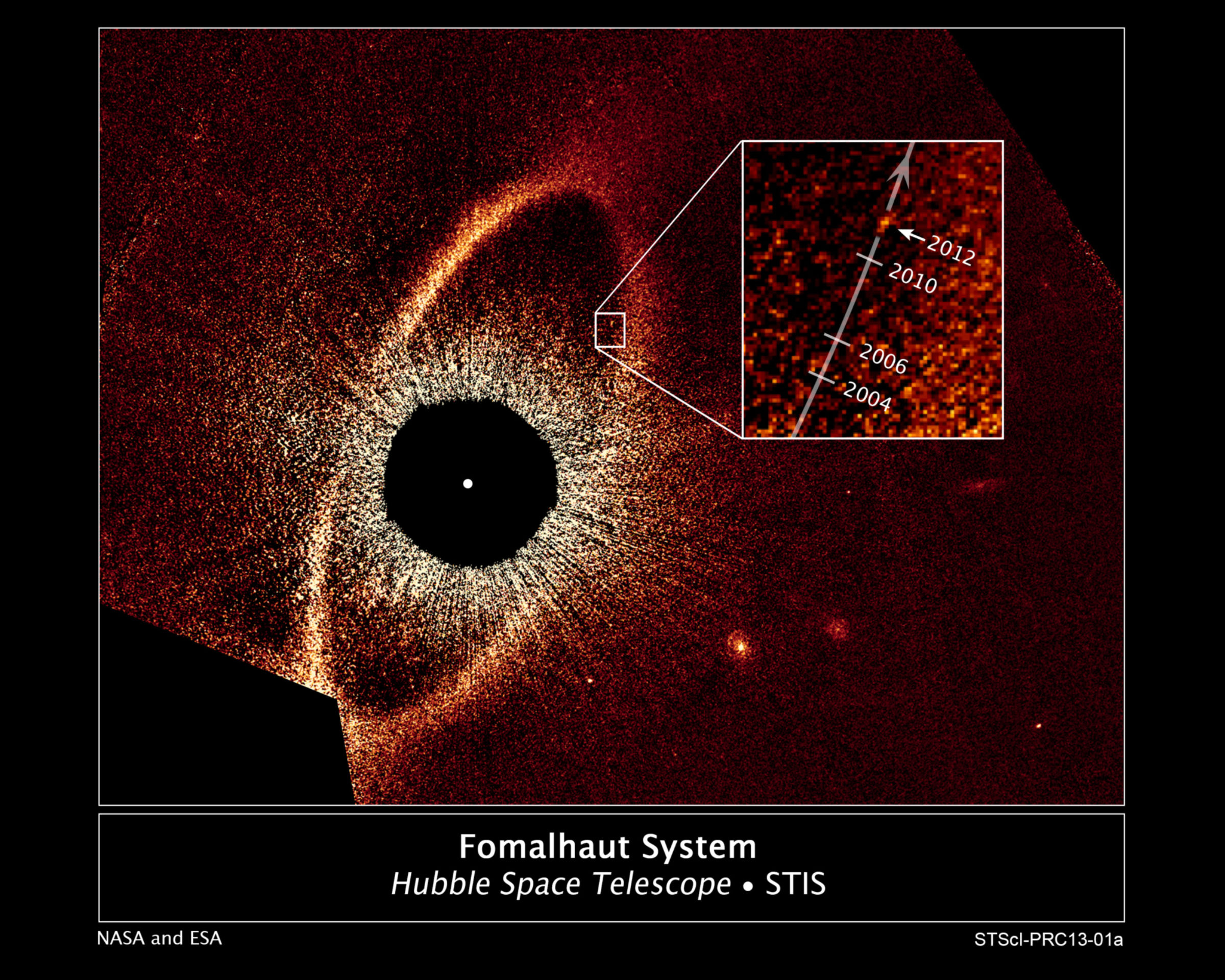
Honorable Mentions
There are a few planets that are more difficult to describe but still worth mentioning because of peculiar characteristics. For instance, we’ve directly imaged a planet orbiting the star Fomalhaut, but we don’t know the planet’s mass or diameter. We know there’s a planet orbiting Proxima Centauri b that’s likely our closest neighboring planet, but we don’t know if it’s a rocky planet like Earth, a sub-Neptune ocean world, or even Neptune-sized; all we know is that its minimum mass is 1.3 times that of Earth. There’s a star called TOI-178 that might have two planets sharing the same orbit, one of them occupying a Trojan point of the other. And we know of at least one free-floating or rogue planet, PSO J318.5-22.
Editorial Notes
This page was written by Emily Lakdawalla and first published on 2 March 2020. Thanks to Emily Sandford for helpful review and comments. Planetary Society naming conventions for exoplanets are the same as for Sky & Telescope magazine: lowercase letter (b, c, etc.) solid with the star name unless the star name ends in a complete word/constellation, with star names as found at exoplanets.org. Examples: Kepler-20b, HD 40309g, 55 Cancri f, GJ 667 Cc (in the last example, C designates the stellar member of the star system, c is the second planet discovered around Gliese 667 C).
Exoplanets, worlds beyond the Solar System
Some exoplanets could be habitable and are prime targets in the search for life beyond Earth.


 Explore Worlds
Explore Worlds Find Life
Find Life Defend Earth
Defend Earth


